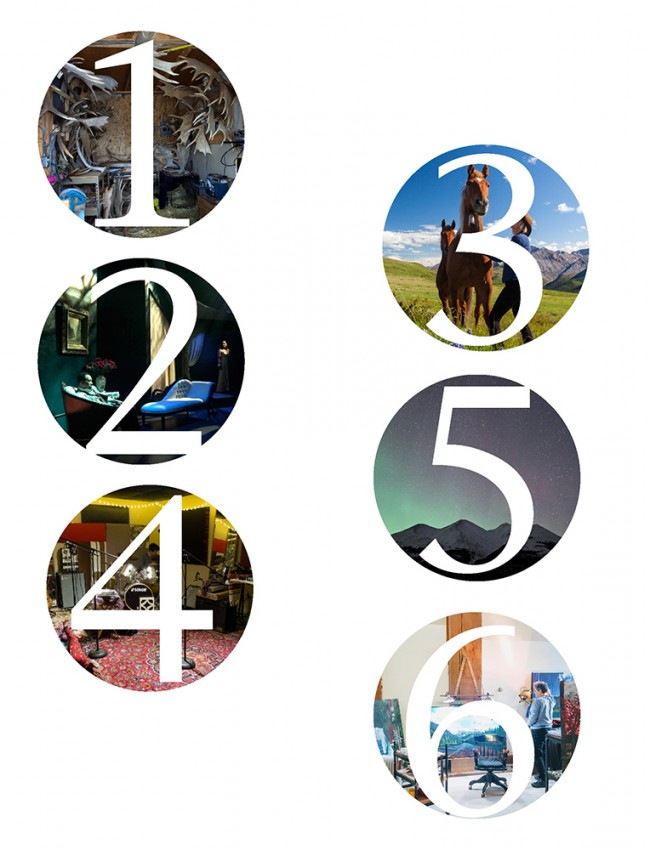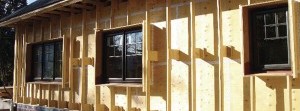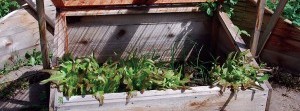
Creative Space
Whatever we create, the environment we are in leaves an imprint on our work. Many artists crave isolation during the creative process, but some encourage outsiders to interrupt and even influence the direction of the pieces. Six northern BC artists discuss their creative spaces and what makes them so significant to the work they produce.
1. BIRD’S PARADISE
Bits of straw are scattered over the floor of the cabin that was once a dog kennel. Antlers hang from the ceiling. When the space is deserted, mice have been known to scuttle across the old bones. “Any time that something gets chewed, it’s part of the story,” Greg explains. “There’s such a story behind an antler.”
The antler storage room breaks off into a smaller space: the workshop itself. It is a six-by-eight room with two large windows that allow the sunlight and shadows to enter. “Anything is possible in here. You just create what you imagine.” The shadows are important. They change the shape of the carvings depending on the direction of the light and the time of day. The sounds of the acreage seep in through the thin walls. The birds in particular draw the artist’s attention away from time to time.
Two Dremel tools hang from the workbench, capable of holding tiny dentistry bits. On the bench sits a piece called “The Adventure”. A bridge of matchsticks connects the branches of bone, and tiny winding staircases careen down the two thick trunks.
This is Greg’s workspace, and when he closes the door he chips away at individual artworks that will take him years to complete. But his large rural property is the space he calls his “last canvas”; the marked and groomed trails where lynx leave their prints, where he has built a pond, extensive gardens and a fine collection of rocks. He sculpts it for his daughter Madi, whom he calls Bird. The property will be hers one day. That’s why he calls it Bird’s Paradise.
Greg Bradacs is a pointillist and carver based in Prince George.
2. TREADING THE BOARDS Buildings have their own stories. Jack’s space was once a bakery warehouse, but its former life is hidden beneath its new skin. The Main Space contains 220 tiered theatre seats with a balcony and a wide, fixed stage, around which are lighting and sound systems controlled from a booth. Beyond the stage are wings for stagehands and actors to hover in anticipation of the next scene. The space morphs with every show that Theatre Northwest brings to Prince George, with actors travelling from across Canada to perform here.
The sets are central to the conversations that swirl around each show. Alice’s set was built on a curve, as though falling down a rabbit hole. “We were constantly building new aspects of it throughout the entire rehearsal process. It was very challenging, not as much for me because I was the one with all of the demands!” Jack’s team crafts maquettes (scale models of the sets) for every production. The maquette for Alice in Wonderland is one of two Jack keeps on his shelf. An effective set isn’t necessarily a complex one. The set for The Secret Mask (Jack’s first show as director with Theatre Northwest) consisted of spinning cubes that displayed images. That decision was a reaction to the reputation Theatre Northwest had for building very elaborate sets. “When I arrived, that’s all people talked about. It really helped in moving the conversation of art forward.”
At Theatre Northwest’s current home, the proximity of the audience to the stage allows for an intimacy that doesn’t exist in larger venues. “If an actor blinks, you can see that. You can see a twitch on the lip, you can see all the little details almost in a filmic quality. If we ever left this space we’d have to find something similar because that’s become our brand. It’s become what we do.”
Jack Grinhaus is the Artistic Director of Theatre Northwest, based in Prince George.
3. A JOURNEY THROUGH THE HOUSE “I knew writers far more productive and accomplished than me who worked from their kitchen table with young children running through the room or whose living-room chair served as their only work space, but it didn’t change the fact that, for me, I had become dependent on a place that provided both space and solitude.”
When Donna moved to a rural farmhouse, the small room beside the kitchen didn’t provide the distraction-free environment she was used to. The space might have worked, except the room beside it was more of a business kitchen than a kitchen kitchen; a space that her husband Wayne invited his eco-tourist clients into. Movement, conversation and the grinding of the coffee machine pushed through the closed door, as did that sense that others were nearby, exacerbating the feeling of being locked in.
The attic was unfinished when they first examined it. Wayne couldn’t stand up in it at its highest point, but for Donna it had exactly what the small room couldn’t offer—seclusion. “I chose a crystal doorknob for the Hobbit-sized door because the space felt magical.” The pair began converting it into a Hobbit-sized workspace. Even as Donna drywalled and painted her new space, questions crept into her mind, questions like, “Why was I always taking the smaller spaces? Why was I viewing my work as less important than Wayne’s?”
Donna soon outgrew the attic, which became unpractical given the unwieldy demands of completing a master’s degree while teaching. She returned to the small room beside the kitchen. When her mother became ill, that room was needed and the hunt began again for a suitable writing space.
“I began to covet Wayne’s luxurious office with an increasing intensity. I decided it was big enough for two. So the furniture that had been moved upstairs and then back down was moved upstairs again.” Wayne’s office was much less luxurious once they were both sharing it. A decade after Donna moved into the farmhouse they built an addition on the back of the property and Wayne moved his office into the addition. Donna now has the creative space that she has spent the past 10 years yearning for, and somewhere between all those transitions she completed her non-fiction book, Summer of the Horse (Harbour Publishing).
Donna Kane is a writer based in Rolla.
4. BACKYARD RETREAT “When you close the second door from within the space you hear a satisfying fwuuup. The sound of locking yourself into a vacuum-sealed space.”
The outside is firmly locked out. It leaves Brennan free to construct his music without interruption. He can crank the volume without worrying about breaking his toddler’s eardrums or driving his sensitive border collie mad. Brennan built a backyard studio where a garage once stood. The stained cedar panelling was brought in from Hazelton. He enlisted a professional carpenter and sifted through hours of Google research to create the perfect environment for generating music and keeping those sounds locked within its walls.
The knowledge that no one else can hear him as he creates is one of the biggest benefits for Brennan. “I used to play inside my house, and as comfortable as I feel with my partner, I always felt that I was kind of performing as there were other ears in the house. I was less willing to sound horrible, to take risks and fall horribly short.”
Brennan’s creative space isn’t all about retreating from the outside world. On Fridays, he invites others in for jam sessions. The space is warmed by the lighting, and deep sofas and Persian carpets make for a welcoming atmosphere. For Brennan, the musical dialogue that transpires is invaluable to his growth as a musician.
Brennan’s proudest accomplishments exist in the collaborative experiences he describes as “fleeting moments of pure communication between players.” Those moments, collectively experienced, may be unrecorded but are at the core of what Brennan dreamt of achieving in this space.
“Creating music with others in an improvised fashion is so visceral. You can move and sense each other so acutely sometimes, and can make the most beautiful moments through listening to each other and supporting each other’s suggestions.”
Brennan Anderson is a Smithers-based music maker.
5. MUSKWA-KECHIKA “You don’t have to look hard when seeking solitude and truly wild spaces around here. Above everything, I always come away with a feeling of gratitude when creating in these spaces.”
The Muskwa-Kechika is a vast wilderness area in northeast BC. Boreal forest meets the Northern Rocky Mountains here. There are wetlands, lakes, rivers, hot springs, and waterfalls—a vast habitat for many species of wildlife. On some clear nights, the aurora washes the sky with colour. “There is just something about this area that still seems so raw and unhindered.” This is Ryan’s creative space.
Ryan is a member of the Fort Nelson First Nation. He explores this landscape and examines the stars above as his Dene ancestors have for many generations. It is not an unchanging place. In the North, change happens fast.
“Summers are busy with the Alaska Highway at its peak. The land becomes wide open for the taking; new blooms, newborn animals, the sun never seems to go down. Next thing you know, winter arrives and everything changes. The days are short, everything a little more desolate, temperatures can dip below -40 degrees. It is important to see the beauty in both.”
Ryan hikes into these remote landscapes with a mirrorless or compact system camera. Travelling alone and on foot necessitates travelling light. His photographs capture rocks and rivers, waterfalls, and sunlight bursting through trees, but also the inhabitants of the region: lynx, moose, owls, bears, bison. Wildlife encounters are part of the experience of trekking through these diverse environments, and he embraces this kind of seclusion.
“I spend a lot of time out in the wild by myself. It forces you to be on the top of your game. Truly wild places demand that type of respect and attention to detail.”
Ryan Dickie is a freelance outdoor and wildlife photographer based in Fort Nelson.
6. AT THE MUSEUM “The studio building overlooks the harbour, which makes it easy for me to go for a walk along the waterfront for a bit of exercise, fresh air and beautiful scenery (and coffee at Cowpuccino’s).”
Suzo’s studio is located inside one of Prince Rupert’s most striking buildings. Exposed beams and high ceilings might describe a trendy artist’s loft in one of Canada’s big urban centres, but here on the coast, Suzo is describing the great cedar longhouse that is the Museum of Northern British Columbia.
Suzo is a painter who has been living in Prince Rupert for the past two years, and she shares her space with a local photographer. Here, she has room to create, to build her canvas stretchers and to store completed pieces and shipping boxes. She often works alone, bringing in the sounds of others through CDs, CBC radio, or audiobooks played on her phone through a small speaker.
“I like its loftiness. Where my easel is set up is under the highest part of the ceiling, it just has a good feeling. The floor is cement and I sit on a rolling chair when I paint. I enjoy the feeling of rolling 20 feet back to look at the painting.”
Suzo appreciates having time to work alone, but she also embraces the influence of others. Her most valued critic, her partner, has multiple sclerosis, so the wheelchair-accessible features built into the museum were a major selling point when Suzo first considered moving in. Foot traffic, particularly during the tourist season, was also attractive.
“I do like drop-ins. I put out a sign that says ‘Painting Studio – Open’ in hopes of luring curious people. It’s nice to have conversations about art and this is one way of making that happen.”
Suzo’s first local exhibit will be at the Ruth Harvey Gallery located within the museum, aptly titled I Like It Up Here (November 23rd, 2018 to January 15th, 2019).
Suzo Hickey is a painter based in Prince Rupert.



